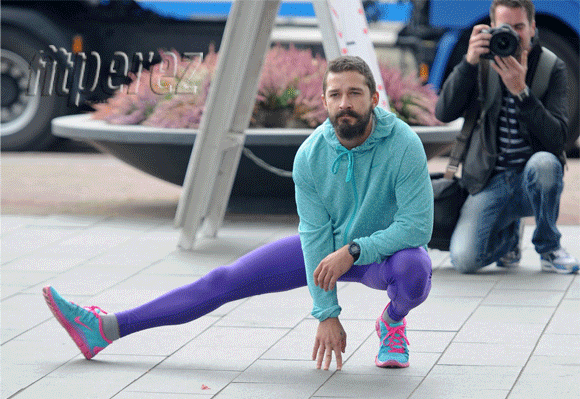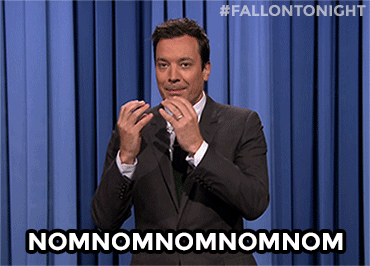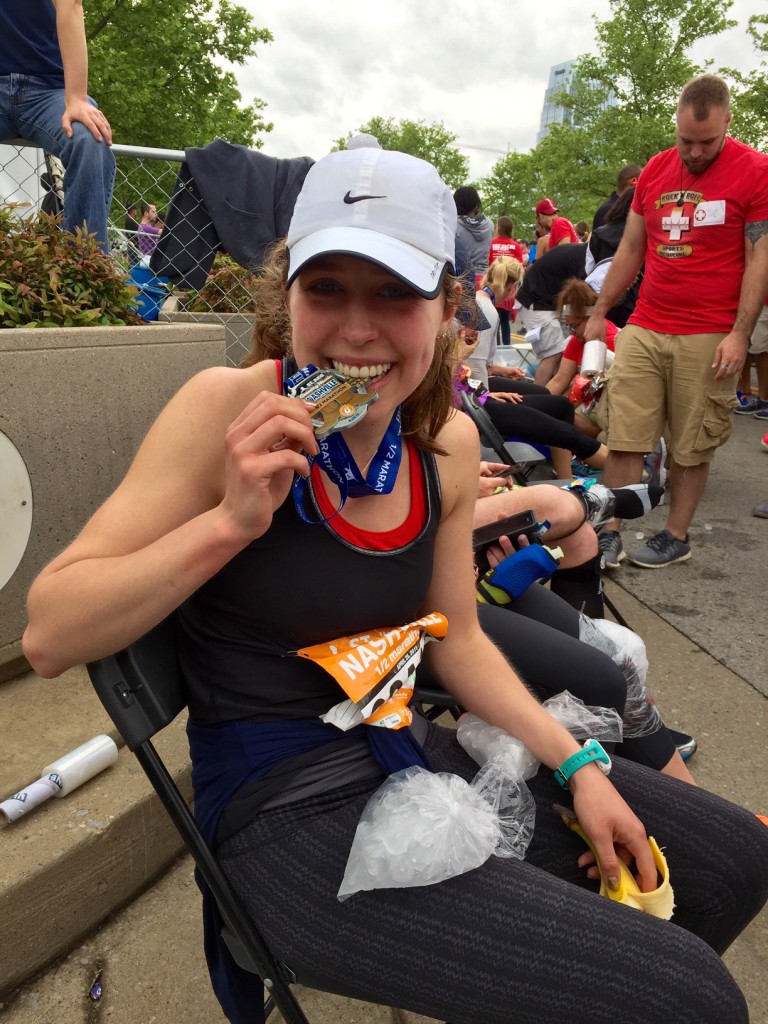Last fall, I began a journey that had been in the making for the better part of four months: training for a half marathon.
At the time, I was “sort of an athlete” in the same way that any freshman in college who had played a high school sport was an “athlete.” I could run a couple of miles with moderate effort, and I could lift some weights. My legs had always been muscular, but years of tennis had made them good for sprints and not so much for distance running. Nevertheless, after watching classmates and sorority sisters run the Country Music Half Marathon in April of my freshman year, I decided I wanted to go for it.
Step One: Get Sporty

Gif courtesy of giphy.com
Towards the end of the summer, I happened to meet a running coach. She’s a family friend and super cool, and when I told her about my plan to run a half marathon, she set me up with a training schedule (you can also find training regimens online, such as this one). I was officially a runner.
That fall, I trained up to 5k distances, and I dropped weight very quickly – we’re talking almost thirty pounds in three months. I took on the half marathon as a bucket list kind of goal, not a weight loss goal, and I’m still not sure how the weight disappeared. I suspect going from 1-2 days of working out a week to 6 played a significant part.
I also joke that I discovered vegetables and salads for the first time, which is mostly true. I never felt bad about my body before I started running, but after, I felt stronger and more fit than ever. I could run 6 miles without stopping instead of struggling to finish 2.5, and I broke an 8-minute mile for the first time in my life. By November, I was at the top of my game.
Step Two: Upgrade Eating Habits

Gif courtesy of giphy.com
By the time I trained up to half marathon distances in January (we’re talking 7, 8, or 9 miles here), I felt like I’d plateaued. I felt intense fatigue on runs, and I couldn’t figure out why.
A conversation with friends and a visit to the doctor revealed the answer: my eating habits were largely to blame. I was not eating enough for the level of activity I was doing. I saw a nutritionist, and she told me about the female athlete triad – the phenomenon in which female athletes, especially runners, think that they have to eat less at peak levels of training in order to get faster.
In reality, they must eat more – often a lot more – and that makes intuitive sense. The more you work out, the more muscle you gain; the more muscle you gain, the more you have to fuel your body before and after exercising. My first reaction was, “well… duh.” It surprised me that I hadn’t thought of it before, and I wondered why.
Perhaps this problem is tied to our image of the female long distance runner (or any other type of professional athlete): as my mom calls them, “legs and lungs.” We see the leanness, the muscles, and the speed. What we don’t see is the professional coaching and observation given to a person who pushes their body that far.
They train hard and eat well and check in on a regular basis with how their body is doing. As laypersons to the professional running game, I and other recreational runners instead imagine that to get faster, we must look like them; to look like them, we must eat less.
There’s an exaggerated connection here between fitness and weight loss, namely that the main way to be healthier and sportier is weigh less. That’s a huge oversimplification of the way the human body works, but it’s a part of the weird math that has saturated conversations about women’s fitness. Every passing fad and Pinterest article transforms food and health from a measurement of well-being to a numbers game of calories in, calories out, Fitbit steps, and pounds on the scale.
It was time to stop thinking of numbers and start thinking of me. I thought that my reduced eating habits from the fall could carry over into the spring, when in fact, they weren’t sustainable in the long term. At the level of activity I planned to take on with steadily increasing training, I could eat twice the amount of food I’d been eating.
Step Three: Fuel Up

Gif courtesy of giphy.com
After that fateful visit, I piled on the healthy foods: eggs, wheat toast, fruit, salads, greek yogurt, cottage cheese – if you can name it, it was on my plate. I stopped counting calories and started trying to balance my meals instead.
I snacked when I was hungry, which became almost constant as my running mileage went up every week. I even took to eating bowls of cereal for dessert or as a snack after a light dinner. People were surprised by the size of my meals, but I took it in stride. This food was for me, not for them, and my body was different than theirs. I couldn’t measure my eating habits based on other people because other people didn’t run as much as I did or work out as often.
I gained at least ten pounds, and I felt better than I had in a month. When you start running 20 miles or more a week, a diet clocking in at under 2000 calories simply isn’t going to cut it. Not for a person under 25, anyway. You don’t have to eat like a fitness fanatic to eat like an athlete: you just have to eat mostly nutrient-dense foods and allow yourself to eat when you’re hungry.
My body was able to do things it couldn’t before because it had muscles it didn’t have before, and I was hungry because I needed fuel. Once I realized that, I was able to run farther and faster than before, and my energy levels were back to normal. It was wonderful.
Step Four: Run, Forrest, Run

Photo by Mary Schatzman
If you’re waiting in suspense, I did finish the half marathon. When my stomach finally settled down enough to eat afterward, I consumed everything I could find within the market near my dorm. At the time, that was two bagels, two bananas, a protein bar and a bottle of Powerade. Not as weird as what these guys ate, but it was still a beautiful moment.
My relationship with food has never been the same. I don’t believe in “cheat days” anymore, or in “bad” foods. I believe in nutritious foods and tasty foods, even when those don’t overlap. I believe in eating one of my mom’s fresh baked cookies when I’m home and eating vegetables as much as I can. I believe in finishing an entire DeSano’s pizza in one sitting if I feel like it, darn it.
If you’ll forgive the tacky metaphor, I like to think of my body as a car and food, by extension, as fuel. Some fuel will make me run better than others (this metaphor will be over soon, I promise) but some fuel is only $1.59 in certain states and is what I want to fill up with at the time. I wouldn’t skimp on fuel for my car, so it doesn’t make sense to fall short on food for me, either. Instead of worrying about calories, I try to see how my food makes me feel and base my diet on that.
That attitude doesn’t just work for runners – I think it’s a mindset that would make everyone feel better about themselves and their bodies. Whether you’re a swimmer, a soccer player, a yoga enthusiast, or someone who prefers the elevator to walking up stairs, food is still fuel. To use that horrendous metaphor one last time, everyone’s car/body is different, but until environmentalists make entirely electric cars, we will still need gasoline to fill them.
As for the future, I will continue to work on maintaining a balance between healthy eating habits, exercise, and letting myself rest when I need it. I want to keep pursuing races and big runs, and with another half marathon coming up in March, I have the perfect opportunity to improve my time from last year. Most importantly, you better believe that after that race, I’ll eat a bigger brunch than you ever thought possible.




